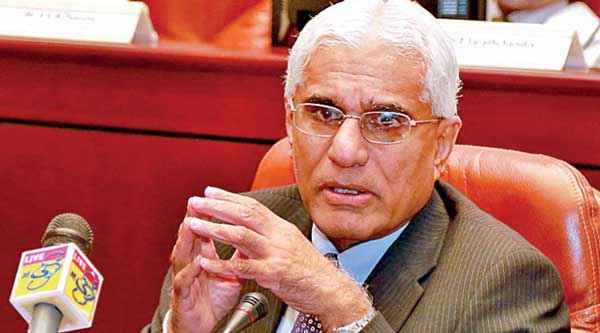Reply To:
Name - Reply Comment
 Dr. Indrajit Coomaraswamy
Dr. Indrajit Coomaraswamy
Pic by Damith Wickramasinghe
The Monetary Board of the Central Bank yesterday decided to keep the key policy interest rates unchanged as “policy measures adopted during the first seven months of the year through increasing policy interest rates and the Statutory Reserve Ratio (SRR) is being transmitted to the economy gradually.”
“As such, the growth in monetary and credit aggregates is likely to decelerate during the remainder of the year to a level supportive of maintaining mid-single digit inflation in the medium term,” the Central Bank said. Accordingly, the Standing Deposit Facility (SDF) rate and the Standing Lending Facility Rate (SLFR) will remain at 7.00 percent and 8.50 percent respectively. Statutory Reserve Ratio (SRR) also remains unchanged at 7.50 percent.
The Monetary Board in its last meeting increased the policy rates by 50 basis points for the second time since last December to tame inflationary pressures fuelled by extremely high credit growth.
However, despite this rate hike, the private credit growth still remains obstinately very high. According to the Central Bank, the credit granted to the private sector by commercial banks continued to increase at a significantly high rate of 28.2 percent in June 2016, on a year-on-year basis, in comparison to 28.0 percent recorded in the previous month.
“A high intake of credit to the industry and service sectors together with a substantial growth in personal loans and advances drove the credit expansion during the first half of the year,” the Central Bank said.
Reflecting these developments, the growth of broad money (M2b) accelerated to 17.0 percent in the month of June 2016 from 16.5 percent recorded in the previous month.
“According to the available indicators, the high growth of private sector credit and broad money has continued in to the month of July 2016 as well,” the Central Bank said.
In the meantime, short term interest rates increased considerably in response to monetary tightening measures adopted by the Central Bank during the first seven months of the year, leading to a sharp upward adjustment in both lending and deposit rates in the financial sector.
Meanwhile, both headline and core inflation edged down in July 2016 largely due to the suspension of the implementation of the Value Added Tax (VAT) by the Supreme Court and normalization of the supply side factors. However, the Central Bank said the underlying upward trend in inflation, as reflected in annual average price changes have continued thus far during the year.
On the external front, the deficit in the trade account is estimated to have expanded by 2.2 percent during the first half of 2016, on a year-on-year basis, as external demand remained relatively weak.
Meanwhile, gross official reserves were estimated to have improved to US $ 6.5 billion by end July 2016 from US $ 5.3 billion in end June 2016.
Despite the private credit growth accelerated to Rs.76 billion in June and a similar trend is expected in July, the Central Bank Governor expects the growth in private credit would ease to 18 percent by the end of the year, within the monetary authority’s 20 percent upper band.
However, such easing in credit largely hinges on how discipline the government in handling its fiscal account given the suspension in the value added tax (VAT) in mid July by the Supreme Court, Dr. Indrajit Coomaraswamy said.
“Our expectation is that by the end of the year, given the current policies and if the government’s fiscal outcome stays pretty much on track, then hopefully the private credit growth would come down to about 18 percent,” he told reporters following the release of the monetary policy review yesterday.
The monetary tightening measures undertaken by the Central Bank earlier this year however so far have failed to bring the desired effect as the private credit continued to grow rapid pace while the headline inflation too peaked to 6.0 percent in July – indications of an overheating economy.
During the first six months the credit granted to the private sector now stands at Rs.349 billion, half of Rs.692 billion private credit granted during 2015.
Much of this credit has been channeled into the real estate and construction sector as some of the stalled infrastructure development projects resumed while construction activities in the economy overall picked up. The growth in credit into the construction sector alone has picked up by 40 percent year-on-year (yoy) in June from around 30 percent growth a year ago, the Central Bank data showed. The private credit into the consumer durables has also risen by little under 60 percent yoy in June.
Meanwhile, in a positive development the loans granted to the public sector has declined by Rs.38 billion during the first six months of 2016, predominantly due to the net repayment of loans by the Ceylon Petroleum Corporation and Ceylon Electricity Board.